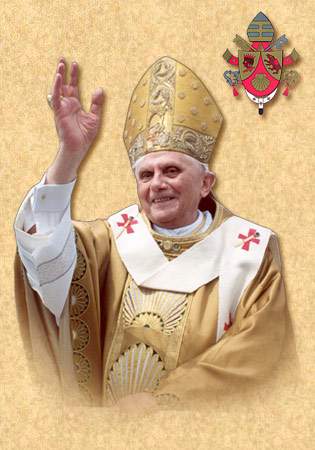Altar Rail Returning to Use - Vuelven a usarse los comulgatorios
Que sepamos, ni el CVII ni ninguna normativa posterior de la autoridad eclesiástica dispuso la supresión de los reclinatorios (altra rails). Empero, dicha supresión se impuso como una desvastación universal, al igual que tantas otras novedades, siempre impulsadas por el clero reformista, nunca por los fieles, a saber, la comunión de pie, la supresión del velo de las mujeres, el altar cara la pueblo, la depredación de tantísimos retablos artísticos y venerables, la confesión de las mujeres cara a cara, la supresión de imágenes, la supresión o, por lo menos, la disminución de los confesionarios o su reemplazo por unas oficinas tras de un vidrio con una mesa entre el sacerdote y el penitente, el idioma vernáculo a lo largo de todo el desarrollo de la misa con la consecuente y total supresión del latín.
Todo ello fue por la imposición de leyes inexistentes, pero en muchos casos irresistibles, a las que la casi totalidad de los obispos y sacerdotes se sometieron escrupulosamente, con gravísimo perjuicio para nuestra santa religión y las almas de los fieles.
Por lo cual es de celebrar esta tendencia de restablecimiento de los reclinatorios, consonante con las costumbres litúrgicas que el Santo Padre Benedicto XVI viene practicando en sus celebraciones, en línea con los usos litúrgicos tradicionales, que tantos beneficios trajeron durante siglos al culto divino y a la expansión del apostolado de la Iglesia. Hacemos votos para que estos ejemplos se propaguen lo más posible en nuestro país, y adoptados sin temor por nuestros obispos y párrocos, para mayor gloria de Dios y exaltación de la Santa Madre Iglesia.
Altar Rail Returning to Use
Architects, pastors and parishioners find it enhances reverence in church.
by JOSEPH PRONECHEN 07/02/2011 CommentsIn Tiverton, R.I., when some parishioners suggested returning altar rails to the sanctuary of Holy Ghost Catholic Church, Father Jay Finelli gladly accepted, little knowing shortly thereafter the Pope’s 2007 motu proprio letter Summorum Pontificum would follow and he would be interested in learning how to celebrate the extraordinary form of the Mass.
In Norwalk, Conn., when a groundswell of parishioner support encouraged pastor Father Greg Markey to restore St. Mary Church, the second-oldest parish in the diocese, to its original 19th-century neo-gothic magnificence, he made sure altar rails were again part of the sanctuary.
Altar rails are present in several new churches architect Duncan Stroik has designed. Among them, the Thomas Aquinas College Chapel in Santa Paula, Calif., the Shrine of Our Lady of Guadalupe in La Crosse, Wis., and three others on the drawing boards.
Altar (Communion) rails are returning for all the right reasons.
Said Father Markey: “First, the Holy Father is requiring holy Communion from him be received on the knees. Second, it’s part of our tradition as Catholics for centuries to receive holy Communion on the knees. Third, it’s a beautiful form of devotion to our blessed Lord.”
James Hitchcock, professor and author of Recovery of the Sacred (Ignatius Press, 1995), thinks the rail resurgence is a good idea. The main reason is reverence, he said. “Kneeling’s purpose is to facilitate adoration,” he explained.
When Stroik proposed altar rails for the Shrine of Our Lady of Guadalupe, “Cardinal [Raymond] Burke liked the idea and thought that was something that would give added reverence to the Eucharist and sanctuary.”
In Eastern Orthodox churches, there is an iconostasis — a wall of icons and religious paintings that separate the nave from the sanctuary — rather than altar rail separating the sanctuary. While the altar rail is usually about two feet high, the iconostasis veils most of the sanctuary.
“The altar rail is nothing compared to that,” he says, “and these are our Eastern brethren. We can benefit and learn something.”
Altar Rail History
They may be returning, but were altar rails supposed to be taken out of sanctuaries?
“There is nothing in Vatican II or post-conciliar documents which mandate their removal,” said Denis McNamara, author of Catholic Church Architecture and the Spirit of the Liturgy (Hillenbrand Books, 2009) and assistant director and professor at the Liturgical Institute of the University of Saint Mary of the Lake in Mundelein, Ill.
Cardinal Francis Arinze strongly affirmed this point during a 2008 video session while he was still prefect of the Congregation for Divine Worship and the Discipline of the Sacraments: “The Church from Rome never said to remove the altar rails.”
So what happened?
“Unfortunately, democratic ideas came into the situation after Vatican II,” Hitchcock said.
Stroik points some out of these ideas: a general iconoclasm that rejected the past, a desire to make churches into gathering spaces more like Protestant meeting houses, and the argument that kneeling is a sign of submission, which is seen as disrespectful to the modern person — we didn’t kneel before kings and queens, so it was more “democratic” not to kneel.
Added McNamara: “Some people called them ‘fences’ which set up division between priest and people.”
“Of course,” he said, “theologically there is a significant meaning in the distinction between nave and sanctuary. Just as there was confusion over the roles of ordained and laity at the time, so there was confusion about the architectural manifestation of those roles.”
Altar rails give “a clear designation as to what is the sanctuary,” Father Markey said. “The word ‘sanctuary’ comes from the word ‘holy,’ which means ‘set apart.’ The sanctuary is set apart from the rest of the church because it reinforces our understanding of what holiness is. The sanctuary is symbolically the head of the church and represents Christ as the head.”
McNamara traces church architecture roots to the Temple of Solomon: The large room corresponded to the church nave; the Holy of Holies, an image of heaven, corresponded to today’s sanctuary. They were separated visually by the great veil, which was torn when Christ died.
“[The altar rail] is still a marker of the place where heaven and earth meet, indicating that they are not yet completely united,” McNamara explained.
“But, at the same time, the rail is low, very permeable, and has a gate, so it does not prevent us from participating in heaven. So we could say there is a theology of the rail, one which sees it as more than a fence, but as a marker where heaven and earth meet, where the priest, acting in persona Christi, reaches across from heaven to earth to give the Eucharist as the gift of divine life.”
Reverence at Mass
Altar rails have an important role for the extraordinary form of the Mass where, Father Finelli noted, reception of Communion has to be on the tongue. He celebrates the extraordinary form weekly in Advent and Lent and monthly the rest of the year.
Communicants kneel at the oak railing that was crafted by a parishioner who is a professional woodworker. The rail was gilded by parishioners. They crafted a similar altar rail for the adoration chapel.
The presence of the rails has made an impression on the 2,000-family parish. “So many people kept requesting to use the altar rail,” he recalled, “I decided at the beginning of Lent that people receive at the altar rail.” (The requirement is for all weekday and special feast Masses in the ordinary form too.)
Given the option to kneel or stand, many choose to kneel to receive Communion. While they can receive on the tongue or in the hand, more people are choosing to receive on the tongue.
As Father Finelli put it, “It’s a very strong sign for the love and respect for the Real Presence because it’s really Jesus we’re receiving.”
Father Finelli clarifies that for Latin Catholics to receive the Eucharist while standing and in the hand is an indult, a special permission granted by the Holy See, because the ordinary way by Church law is still to receive while kneeling and on the tongue. (The indult was granted at the request of the American bishops.)
While the extraordinary form is celebrated three times weekly at St. Mary’s in Connecticut, Father Markey says the Communion rails are used for all ordinary form Masses as well. In his 1,000-family parish, parishioners also have the option at the ordinary form to kneel or stand.
This is approved by Rome. He notes the Vatican directive: “In 2003 the Congregation for Divine Worship and the Discipline of the Sacraments says in the ordinary form ‘communicants who chose to kneel are not to be denied holy Communion … nor accused of disobedience …’”
Stroik designed St. Mary’s renovated sanctuary incorporating hand-carved marble neo-gothic altar rails with brass gates that Father Markey purchased from a church that was closing in Pennsylvania. It beautifully matches the original white marble fixed altar and new marble free-standing altar, which brings another dimension to liturgical symbolism.
“When we gather at the altar rails, we symbolically gather at the altar,” Stroik said.
Making both altar and rails from the same materials — in this case marble — makes the connection even clearer.
Liturgical architecture expert McNamara agrees. He has found that some old church architecture books consider the rail the “people’s altar” and thus was made with the same marble as that of the altar.
To add to the symbolic connection, some churches cover the rails during Communion with linens similar to those on the altar.
Drawn to Prayer
There are yet more reasons for incorporating altar rails. Stroik finds where they have been removed in a cathedral, basilica or historic church receiving numerous visitors, many don’t know how sacred the altar is and wander around the sanctuary. The church has to put up ropes and signs like in a museum to do what altar rails were supposed to do: “create a real threshold so people can tell it’s a special place, a holy place set apart.”
Stroik says the altar rail is “an invitation for people to come close to the sanctuary, kneel and pray before the tabernacle, a statue of Our Lady or images of saints.”
Father Markey said returning the rails has been a great success.
Longtime parishioners who have attended St. Mary’s for 50 years or more regretted the magnificent altar rail being torn out in the 1960s. They now tell him, “Thank God you brought it back, Father.”
He also notices worship is enhanced for adults as well as children: “Little children like to kneel and pray there while their mom and dad receive holy Communion,” said Father Markey. “There’s almost universal embracing. It’s one of the most popular decisions I’ve made as pastor.”
Register staff writer Joseph Pronechen is based in Trumbull, Connecticut.
Visit StMaryNorwalk.net and Ho
Read more: http://www.ncregister.

